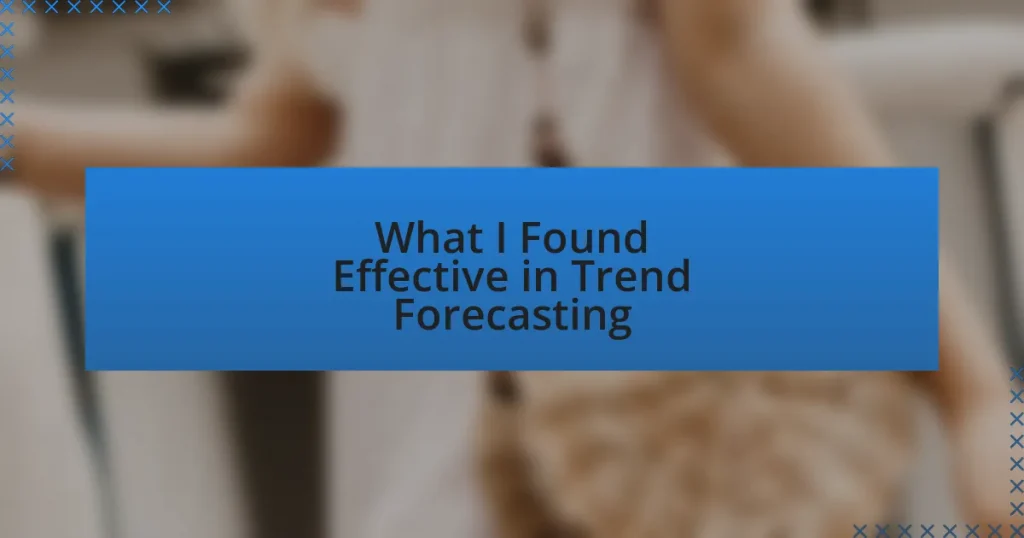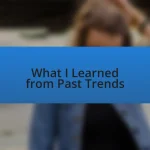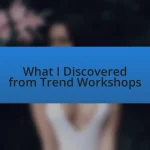Key takeaways:
- Trend forecasting requires understanding cultural currents and consumer behavior, influenced significantly by social media and sustainability values.
- Effective trend analysis combines data with intuition, emphasizing the importance of collaboration and community insights in shaping trends.
- Future trend forecasting will likely leverage data analytics and AI to predict shifts while prioritizing sustainability and meaningful consumer connections.
Author: Charlotte Hawthorne
Bio: Charlotte Hawthorne is an acclaimed author known for her compelling storytelling and richly drawn characters. With a passion for exploring the complexities of human relationships, her novels often blend elements of romance, intrigue, and self-discovery. A graduate of the University of California, Charlotte has received multiple awards for her work, including the prestigious Silver Quill Award. When she’s not writing, she enjoys hiking in the Sierra Nevada mountains and sipping coffee at local cafes. Charlotte currently resides in San Francisco with her rescue dog, Jasper.
Understanding trend forecasting
Trend forecasting is more than just predicting what will be in vogue; it’s about understanding the cultural currents that shape consumer behavior. I remember attending a fashion seminar where the speaker emphasized how societal shifts, like the rise of sustainability, were fundamentally altering trends. It made me realize that trends often reflect deeper values, making them essential to grasp for anyone wanting to stay relevant in the fashion world.
When I first started in the industry, I underestimated the power of social media as a trend barometer. I would scroll through my feeds, seeing certain styles repeatedly pop up, and it dawned on me: trends emerge from conversations happening online. Isn’t it fascinating how a single influencer can sway the direction of a whole season? Our engagement with these platforms allows us to see shifts in real time and helps us anticipate what consumers might want next.
Understanding trend forecasting also requires a blend of data and intuition. I often find myself analyzing sales figures, runway shows, and even street style; it all contributes to a larger picture. Have you ever noticed how your own preferences evolve? That’s the essence of trend forecasting—recognizing those subtle shifts and acting on them before they become mainstream. It’s a thrilling challenge that keeps the fashion conversation alive.
Importance of trend forecasting
Grasping the importance of trend forecasting is essential for anyone in the fashion industry. I’ve seen firsthand how brands that fail to analyze emerging trends often miss out on capturing their audience. For instance, I once worked with a small label that overlooked the growing preference for eco-friendly materials, and they struggled to connect with consumers who had shifted their values toward sustainability. Isn’t it surprising how quickly preferences can change?
Moreover, trend forecasting serves as a roadmap for innovation. When I began my career, I remember developing a new collection based on insights I gathered from a mix of street style and international fashion weeks. The result was a line that not only reflected current trends but also pushed boundaries. This experience taught me that forecasting is about more than just following the crowd; it’s about leading it.
Finally, trend forecasting fosters a connection between brands and their consumers. I often find it gratifying to see how a carefully predicted trend resonates with shoppers, creating a shared sense of excitement. Have you ever felt that thrill when you see a trend you love becoming mainstream? That’s the beauty of trend forecasting—it builds anticipation and creates rich narratives that unify the fashion community.
Methods for effective trend analysis
Understanding the methodologies behind effective trend analysis is crucial. One method I have found particularly insightful is analyzing consumer behavior. By immersing myself in social media platforms and observing how users engage with various styles, I can identify patterns in preferences. This isn’t just about liking photos; it’s about discerning why certain trends resonate. Have you noticed how a simple hashtag can ignite a fashion revolution?
Another effective technique involves collaborating with trend forecasting agencies. Early in my career, I partnered with an agency that provided invaluable insights into future color palettes and fabrics. They often shared reports highlighting shifts in consumer attitudes, which guided our design decisions. It was eye-opening to see how data informed creativity, pushing me to consider factors I hadn’t previously thought about. What about your experiences—have you ever felt out of sync with the market because you lacked the right insights?
Surprisingly, sometimes the best analysis comes from intuition. During my time at a boutique, I often relied on gut feelings shaped by continuous observation. One season, I intuitively sensed a shift toward bold patterns, which led to a successful collection that really stood out. This approach taught me that while data and research are critical, there’s also a unique power in trusting your instincts. How often do you allow your intuition to guide your creative decisions in fashion?
Resources for trend forecasting
When it comes to resources for trend forecasting, I often turn to a variety of industry reports and online platforms like WGSN and Trendstop. These platforms compile extensive research and analysis on upcoming trends, offering insights that can really sharpen our approach. I still remember pouring over a WGSN report that completely transformed my understanding of consumer expectations; the clarity it provided made narrowing down design choices feel less daunting. Have you ever relied on a single source to guide your decisions, only to realize the wealth of information available?
In addition to reports, I’ve found that attending fashion trade shows can be an incredibly effective resource. Walking through these events, I immerse myself in the vibrant energy of innovative designs and color palettes. One experience that stands out was when I stumbled upon a booth showcasing sustainable materials, which sparked a new direction for my collections. The dynamic atmosphere at these shows always inspires me to think outside the box—what about you? Do you find inspiration in face-to-face interactions with industry peers?
Lastly, I can’t stress enough the power of community resources like local fashion groups and online forums. Engaging with fellow designers and trend enthusiasts provides a fresh perspective that can be just as valuable as formal research. I remember a lively discussion in a local fashion hub where someone suggested we explore vintage styles—this led to a surprising resurgence of retro aesthetics in my work. Have you tapped into your community for insights? It’s often the conversations we have that can lead to the most unexpected inspirations.
Personal experiences with trend forecasting
When I first ventured into trend forecasting, I relied heavily on seasonal fashion weeks to gauge what would resonate with audiences. The thrill of witnessing firsthand the emerging styles on the runway was unforgettable; I remember the electric feeling in the air as designers unveiled their collections. Have you ever felt that rush of excitement, knowing you were among the first to spot a trend taking shape?
A particularly enlightening experience occurred during an online webinar featuring industry experts discussing the impact of social media on trend cycles. It was fascinating to hear how platforms like Instagram can accelerate the visibility of certain styles. After that session, I started observing my own social media feeds more critically, trying to discern the patterns in what was gaining traction. How much do you consider social media when predicting trends in your own projects?
One of my most memorable moments came when I collaborated with a small team of designers to create a capsule collection. We poured over mood boards and discussed emerging patterns together, which illuminated just how collaborative trend forecasting could be. The project not only deepened my appreciation for collective creativity but also made me realize that insights often emerge in surprising ways. Have you ever worked closely with others to unearth trends that might have otherwise gone unnoticed?
Tips for implementing trends
When it comes to implementing trends, one of the most valuable strategies I discovered is to start small. For instance, experimenting with statement accessories or color pops can help gauge audience response without overwhelming your existing style. Have you ever tried incorporating a bold piece into your wardrobe? The feedback you receive can inform how far you can take the trend.
Another effective method I’ve found is to pair emerging trends with timeless pieces. I remember mixing a flowy, trendy blouse with a classic pair of jeans for a casual event—resulting in a look that felt both current and enduring. It’s a reminder that blending the old with the new can create a unique and relatable style. How do you balance trendy pieces with your own personal aesthetics?
Moreover, actively engaging with your audience can be a game changer. I often ask my followers for their thoughts on various trends through polls or discussions. Their insights not only help me refine what to adopt but also foster a sense of community around shared style choices. Have you ever sought feedback on your trends? It can be enlightening to learn what resonates with others in your circle.
Future outlook on trend forecasting
The future of trend forecasting seems poised for exciting evolution. With the rise of data analytics and AI, I anticipate that trend forecasters will harness these tools to predict shifts more accurately. Remember how it felt to confidently wear the chunky sneakers trend? I believe that soon, algorithms will help us understand not only what’s in vogue but also why certain styles resonate season after season.
Additionally, I am increasingly aware of the role social media plays in shaping trends. I’ve seen first-hand how a seemingly simple hashtag can propel a local designer into the global spotlight overnight. This interconnectedness means that tomorrow’s trends will likely be influenced by diverse cultural moments, urging all of us to stay attuned to broader global narratives. Have you ever found inspiration from a street style photo shared thousands of miles away? That’s the magic of modern forecasting.
Looking ahead, sustainability will undoubtedly become a cornerstone of trend forecasting. As consumers, we are becoming more conscious of the impact of our choices. I once stood in my closet, reflecting on the amount of fast fashion I had amassed, and felt compelled to change my approach. This shift calls for a forecasting mindset that prioritizes longevity over mere novelty, encouraging us to invest in pieces that tell a story rather than follow fleeting whims.


